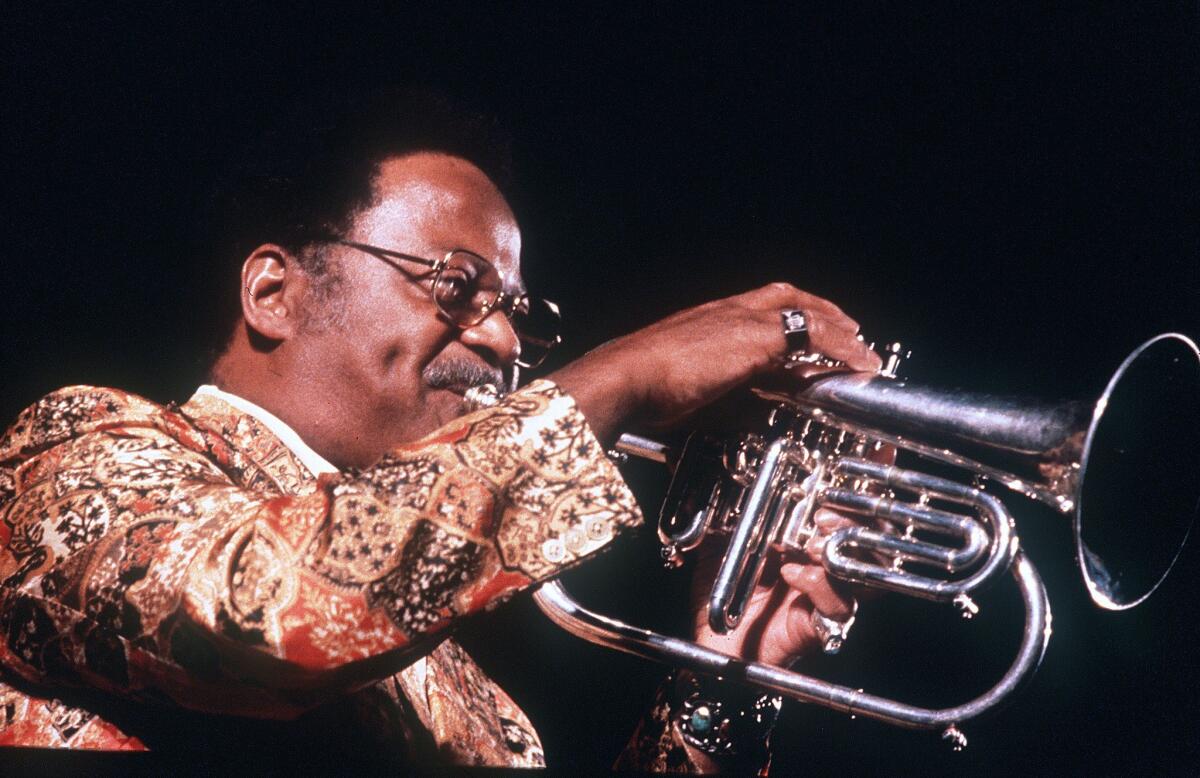Clark Terry dies at 94; jazz trumpeter with Ellington and ‘Tonight Show’

- Share via
Clark Terry, a versatile jazz trumpeter and fluegelhorn player whose long career included stints with Count Basie, Duke Ellington, Quincy Jones, Billie Holiday, Oscar Peterson and a 12-year run in the NBC Tonight Show Orchestra as the network’s first African American staff musician, has died. He was 94.
He had long battled diabetes and died of cardiac complications Saturday at Jefferson Regional Medical Center in Pine Bluff, Ark., said his stepson Gary Paris.
------------
FOR THE RECORD
1:25 p.m.: A previous version of this story said Terry died in Pine Bluffs, Ark.; the city is Pine Bluff.
------------
“Terry wraps up all the best aspects of jazz both as art and entertainment,” jazz critic Leonard Feather wrote in The Times in 1973. “He is melodic, he has his own sound, his own phrasing, his own puckish sense of humor.”
That sense of humor, present from his youth, became an unexpectedly significant part of his musical persona in the 1960s, via a whimsical, muttering scat singing style that Terry created on a spontaneous blues recording with Peterson called “Mumbles.”
But the core of Terry’s art was the trumpet, an instrument he’d coveted from his pre-teen years in his hometown of St. Louis. From the time he first came to prominence with the Duke Ellington Orchestra in the early ‘50s, he was universally admired by other trumpeters for his mastery of the instrument.
Capable of articulating notes with stunning rapidity, he was also an expert with the difficult technique called circular breathing, which allows a wind instrumentalist to play continuous long notes or extended phrases without having to interrupt the musical flow to take a breath.
At times, he used his extraordinary craftsmanship as part of a showcase soloing style, switching from a trumpet in one hand to a fluegelhorn in the other, alternating sounds and styles to play duets with himself. As an ultimate technical feat, he occasionally played a melodic solo using only his lips and a trumpet mouthpiece.
But, great artist that he was, Terry always placed these remarkable skills at the service of an inventive, free-flowing musical imagination. He had the unique ability, Feather said, of playing each note “with a certain elegance and eloquence that bear the mark of total individuality.”
Clark Terry was born Dec. 14, 1920, in St. Louis, the seventh of Clark Virgil Terry and Mary Terry’s 11 children. In “Clark: The Autobiography of Clark Terry,” he reports that his older brothers and sisters had urged his parents to name him John. Although he was instead named after his father, without the middle name, everyone – including his father -- persisted in calling him John throughout his childhood.
Fascinated by jazz, by the music of the Duke Ellington Orchestra and especially by the trumpet, but unable to afford an instrument, Terry made one for himself when he was 10.
“I coiled up an old garden hose into the shape of a trumpet,” he wrote in his autobiography, “and bound it in three places with wire to make it look like it had valves. … And for the bell on the other end, I found a not-too-rusty kerosene funnel.”
His neighbors – less than delighted by the sounds of the contraption – chipped in to buy Terry’s first instrument, a $12.50 pawn shop trumpet.
Terry’s playing skills advanced rapidly, so much so that he inspired another ambitious St. Louis trumpeter, who was only five years younger – Miles Davis.
“He became my idol on the instrument,” Davis wrote in “Miles: The Autobiography.” “I decided I was going to be that hip, even hipper, when I got my [stuff] together.”
After working with local St. Louis bands during his teenage years, Terry served in the U.S. Navy from 1942-45. Returning to civilian life, he played in the bands of George Hudson, Charlie Barnet, Charlie Ventura, Eddie Vinson and Count Basie. In 1951, he achieved one of his most desired ambitions, joining the Duke Ellington Orchestra for an eight-year run.
In 1959, Terry toured with the Quincy Jones Band in the musical “Free and Easy,” and accepted an offer to join NBC’s Tonight Show Orchestra in 1960.
After leaving the show when it relocated to Los Angeles in the early ‘70s, Terry continued his busy recording career, and led various groups of his own – including several big bands.
Over the ensuing decades, Terry, encouraged by pianist and educator Dr. Billy Taylor, expanded his performance schedule to include a deep involvement in the teaching of jazz and the organization and encouragement of hundreds of jazz programs at clinics, high schools and universities in many parts of the world.
Among his many awards, Terry was named a National Endowment for the Arts Jazz Master, and he received a Grammy lifetime achievement award in 2010.
Terry’s last decade was plagued by health problems – colon cancer, high blood pressure and diabetes, which diminished his eyesight and caused the amputation of his right leg. But his wit and his sense of humor never waned. The publication of his autobiography triggered many requests for autographs. When arthritis made it impossible for him to hold a pen, he simply said, “Well, I can’t write, but I’ve got thumbs.” And he proceeded to place an inked thumbprint on the page instead of an autograph.
Terry’s survivors include his wife, Gwen, whom he married in 1992, and stepsons Gary Paris and Tony Paris.
More to Read
Start your day right
Sign up for Essential California for the L.A. Times biggest news, features and recommendations in your inbox six days a week.
You may occasionally receive promotional content from the Los Angeles Times.






